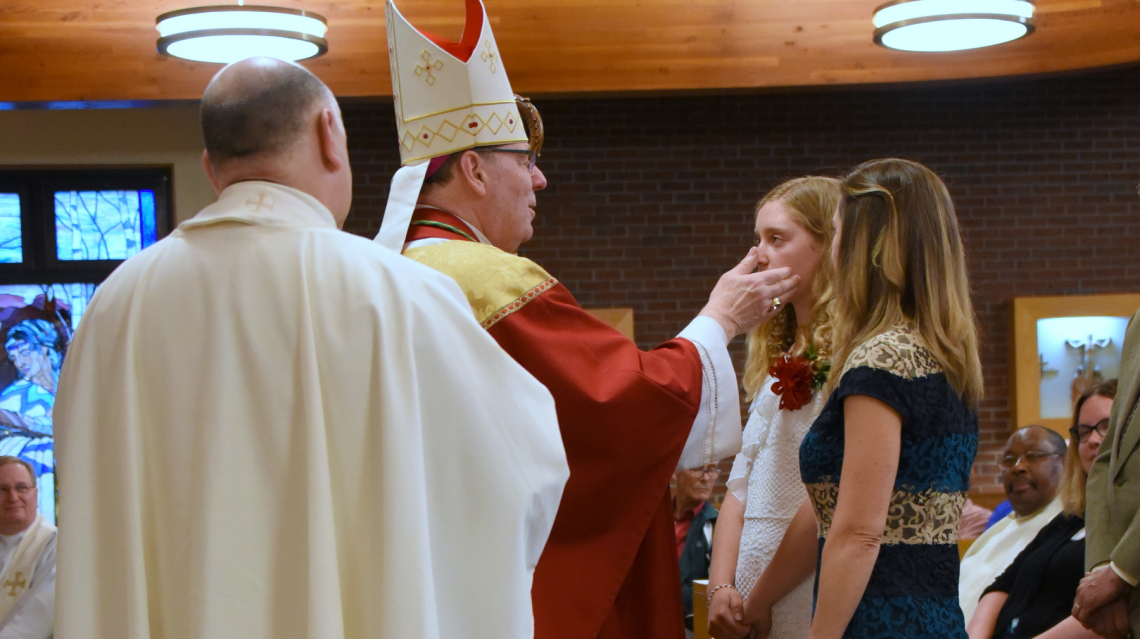The Sacraments - Confirmation

The Sacrament of Confirmation
Confirmation – or chrismation, as it is known to Catholics of the Eastern Churches - is one of the sacraments of initiation. When catechumens are welcomed into the Church at the Easter Vigil, they receive the sacraments of baptism, confirmation, and Eucharist, in that order. Catholics of the Diocese of Portland who are in their thirties (and older) will recall receiving confirmation when they were junior high or high school students, years after their baptism and first Communion. The current practice in our diocese, where second graders receive confirmation and then first Communion, is meant to restore the traditional order of the sacraments of initiation.
Celebrating the sacraments of initiation in the traditional order matters because that order shows that confirmation is closely linked with baptism. Thus, at the Easter Vigil, confirmation comes immediately after baptism. The Catechism of the Catholic Church points out that the sacrament of confirmation is necessary for the completion of baptismal grace: “By the Sacrament of Confirmation, the baptized are more perfectly bound to the Church and are enriched with a special strength of the Holy Spirit. Hence they are, as true witnesses of Christ, more strictly obliged to spread and defend the faith by word and deed” (no. 1285).
Confirmation enriches us with a special strength of the Holy Spirit. The Nicene Creed calls the Holy Spirit “the giver of life.” In the first lines of Genesis, we find the Spirit stirring over the primeval chaos, bringing it order and life. The Spirit empowers people to act in God’s name for Israel so that Israel might turn from destructive ways and be renewed by God’s faithfulness. It is through the Holy Spirit that the Lord Jesus is conceived in the womb of the Virgin Mary. The Spirit builds up the early Church by giving spiritual gifts to each believer for the good of all. This same Holy Spirit fills the hearts of all who are confirmed.
In the celebration of the sacrament of confirmation, three important symbols help us understand more fully its meaning: the bishop, the imposition of hands, and the anointing with sacred chrism. Conformation is closely tied to the diocesan bishop. The bishop is the ordinary minister of this sacrament. Even if a priest is delegated to confirm, sacred chrism consecrated by the bishop is used. The bishop’s presence is a reminder that our faith is not merely an individual experience, nor are we members only of our local parish. The bishop’s presence reminds us that we are connected with the whole Church throughout the world today and with the Church going back through time to the ministry of the Lord Jesus Himself.
In the New Testament, the imposition of hands was used for two purposes: to pray that the Holy Spirit will come upon the newly baptized person and to pray that the Spirit might strengthen someone who has been given a specific ministry. In confirmation, the imposition of hands is a reminder that the Spirit is being given to us so that each of us might be given spiritual gifts for the good of the whole Church.
In Biblical times, oil was seen as a sign of abundance and joy. It offered cleansing and healing. It prepared athletes for competition. It made human bodies radiant with beauty, health, and strength. The kings of Israel were anointed with oil at the beginning of their reign. The word “Messiah” or “Christ” means “anointed one.” The sacred chrism at confirmation reminds us that the Holy Spirit is anointing us to be members of Christ’s body, the Church, in the world. We are being strengthened to face whatever struggles we need to take up because of our mission. We are given life, strength, and beauty as temples of the Holy Spirit.
Once we are confirmed, this gift of the Holy Spirit remains with us. Confirmation, like baptism, is given only once. We can forget or neglect this gift of the Spirit. We can be tempted to shy away from its implications. It is most helpful, then, to make this prayer our own:
Come Holy Spirit, fill the hearts of your faithful
and kindle in them the fire of your love.
Send forth your Spirit and they shall be created.
And you shall renew the face of the earth.
For further reading: Catechism of the Catholic Church, nn. 1285-1321
By: Father Mark Nolette










